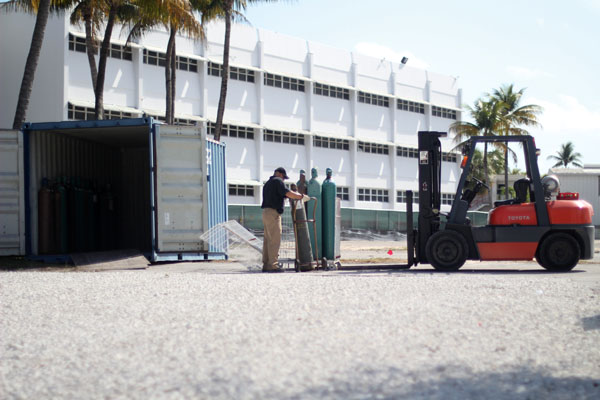

The groundbreaking ceremony for the Marine Technology and Life Sciences Seawater Complex at the Rosenstiel School of Marine and Atmospheric Science (RSMAS) campus on Virginia Key was held on June 7.
The new building will feature the world’s first wind-and-wave tunnel capable of producing Category 5 hurricane-force winds, as well as a marine life science center.
“The wind tunnel will allow us to test how buildings survive in a combination of storm surge and wind,” said William Drennan, RSMAS’ associate dean of undergraduate education.
By building model structures in the tunnel, scientists can see what parts of the structures are the weakest. This will allow for more effective building designs in hurricane-prone areas like South Florida, Drennan said.
Hurricanes represent a great cost to coastal areas. Hurricane Wilma, which struck South Florida in 2005, caused an estimated $20.6 billion in damage, according to the National Oceanic and Atmospheric Administration.
Seawater will be pumped in through the system and channeled underground to the wind-and-wave tunnel to simulate storm conditions, said Gary Hitchcock, director of RSMAS’ undergraduate program. To let seawater in, there will be a pumping, filtration and distribution system close to the bay.
Brian Haus, who will be the director of the new Surge-Structure-Atmopshere Interaction (SUSTAIN) lab, said the complex could help eliminate the limitations that exist because of the mathematical aspects behind building design.
“The formulations for those things are based on data collected at much slower speeds,” Haus said. “There are a lot of things that happen very differently when you pass a certain threshold of wind speed.”
Of the $47 million required to build the complex, $15 million is coming from the National Institute of Standards and Technology (NIST), a part of the stimulus money from the American Recovery and Reinvestment Act (ARRA).
The new building will also be LEED certified, indicating environmental friendliness.
The building will replace two aging facilities, which will be demolished. Fish and other marine species currently being reared in those buildings will be moved into the Marine Life Science part of the complex.
Although the project has hardly begun, Drennan is optimistic about its future impact.
“It’s the first new building we’ve had in 35 years,” Drennan said. “It’ll really change the campus.”
Gustavo Marques, a second-year doctoral student, is excited about the new project.
“It’s cool,” he said. “Scientists are going to be able to innovate new models.”
Completion is scheduled for winter 2013. Until then, there are approximately 100 fewer parking spots on the RSMAS campus because of the construction, according Drennan. Students and faculty members are opting to park at the Miami Seaquarium, which is a five minute walk to RSMAS facilities – however, a UM parking badge is required.
Though there are still several other parking areas on RSMAS, the small size of the campus – compared to UM’s Coral Gables campus – means that most people are affected by the lack of parking in some way. Despite the shortage of spaces, however, many view it as a minor inconvenience at most.
“As long as it’s not too busy, it’s not too bad,” junior Joyce Yager said.
Drennan said that the only thing that students and faculty can do is wait.
“It’s going to be tight parking for the next couple of years,” Drennan said. “But it’s all for the greater good.”






